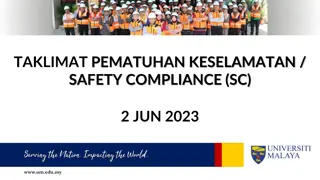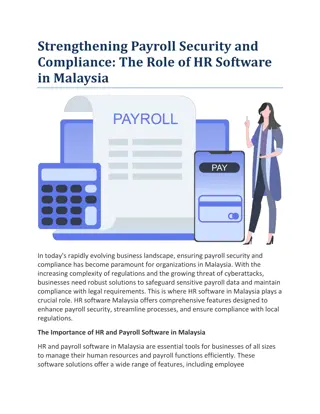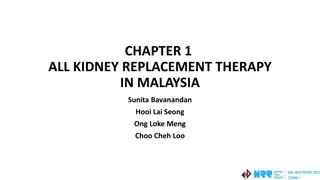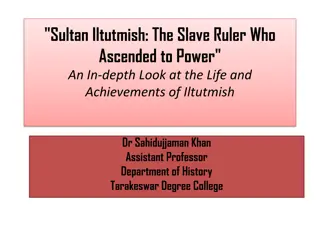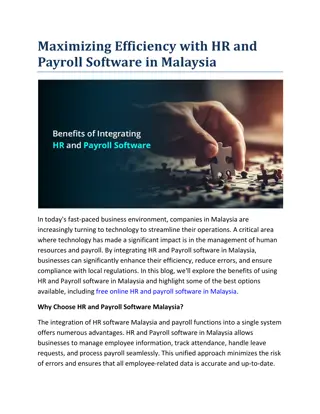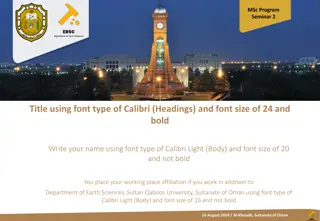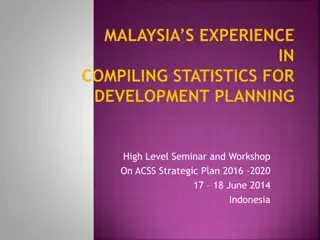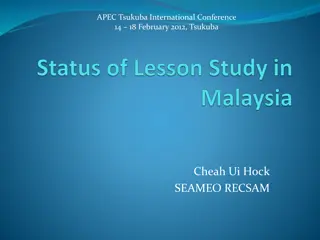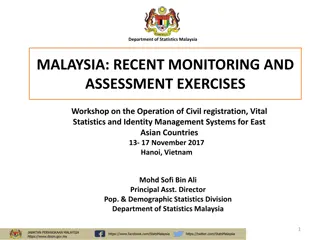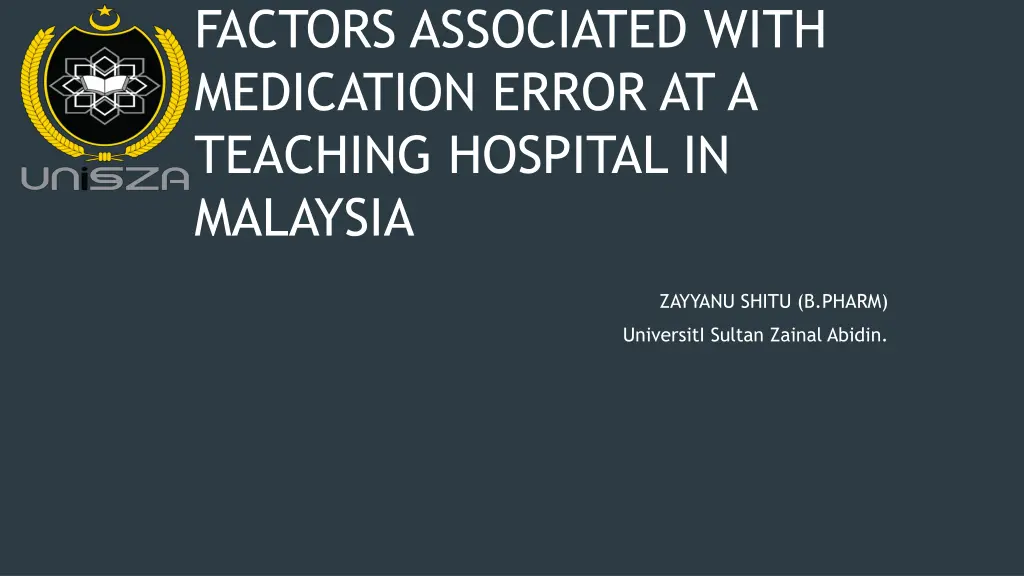
Factors Associated with Medication Error in a Malaysian Teaching Hospital
Explore the factors linked to medication errors in a teaching hospital in Malaysia, focusing on various types of errors and their associations. The study aims to identify these factors in the emergency department of the hospital through a detailed methodology and data analysis.
Download Presentation

Please find below an Image/Link to download the presentation.
The content on the website is provided AS IS for your information and personal use only. It may not be sold, licensed, or shared on other websites without obtaining consent from the author. If you encounter any issues during the download, it is possible that the publisher has removed the file from their server.
You are allowed to download the files provided on this website for personal or commercial use, subject to the condition that they are used lawfully. All files are the property of their respective owners.
The content on the website is provided AS IS for your information and personal use only. It may not be sold, licensed, or shared on other websites without obtaining consent from the author.
E N D
Presentation Transcript
FACTORS ASSOCIATED WITH MEDICATION ERROR AT A TEACHING HOSPITAL IN MALAYSIA ZAYYANU SHITU (B.PHARM) UniversitI Sultan Zainal Abidin.
CONTENTS INTRODUCTION OBJECTIVE METHODOLOGY RESULTS DISCUSSION CONCLUSSION ACKNOWLEDGEMENT REFERENCES
INTRODUCTION Medication error (ME) is defined as preventable ADE due to inappropriate medication use by the healthcare professional or patient. Some medication, more medications prescribed, busy and condition of personnel services, age of patients. Different types of MEs are: Omission error, Wrong time error, Unauthorized drug, Dose error, Dosage form error, Drug preparation error, Route of adm. error, Adm. technique error, Deteriorated drug error. factors associated with ME: longer duration of
OBJECTIVE To identify factors associated with ME in the emergency department (ED) of Hospital Universiti Sains Malaysia.
METHODOLOGY A cross sectional study design was employed. HUSM is a 767-bed, with 65,000 visits to the ED annually. ED is triaged into red, yellow and green zones. Ethical approval was obtained from Ethical Committee of USM. Sample size: 311. Sampling technique:Patient records were randomly selected from the total number of eligible patients (from all treatment zones) to meet the required sample size.
METHODOLOGY Inclusion criteria- Adult (>18 years old), patients visiting the ED between 8 am to 5 pm on ED visit, Sundays to Thursdays. Exclusion prescribed. criteria- Patients who had no medications Data was collected over 9 weeks consecutively from each zone for all eligible patients.
METHODOLOGY Information on socio-demography and medication prescribed by doctors were obtained from patients medical folder. The medication chart contains information such as: name of medication, time medication given, age, gender, ethnicity, time of visit, triage, diagnosis, number of medications given, concurrent medical and medication history and allergic history.
METHODOLOGY DATAANALYSIS: Data obtained was entered into the SPSS (version 22). Univariable analysis using performed to identify variables associated with ME. Variables with a p<0.25 was considered to be unadjusted, significant associated factors. Multivariable analysis was done to determine the independent factors associated with ME. Variable selection method with backward likelihood ratio was employed. simple logistic regression was
RESULTS 95 (30.5%) of the patients had at least one ME Univariable analysis: Gender, ethnicity, age, concurrent medication, concurrent medical illness, time of patient s ED visit, triage and number of received medications prescribed were found to be unadjusted significant associated factors (p < 0.25). Multivariable analysis: triage (p <0.001), the number of medications (p <0.001), time of visit (p= 0.007) and gender (p= 0.03) were found to be significant associated factors (p<0.05). There was no multi-collinearity and interaction between the model. Model correctly classified 83.9% of the model and ROC was 84.9%.
FINAL MODEL Adjusted ORb (95% CI) Variables Wald Statisticb(df) p-value* Gender Male Female 1.00 0.50 (0.26, 0.93) 4.710 (1) 0.030 Time Morning session (8am-12pm) Early afternoon (12pm-2pm) Late afternoon (2pm-5pm) Triage Red Yellow Green 0.34 (0.15, 0.75) 0.55 (0.27, 1.12) 7.191 (1) 2.709 (1) 0.007 0.100 0.51 (0.25, 1.03) 0.11 (0.04, 0.27) 3.55 (1) 21.397 (1) 0.060 <0.001 Number of medications 1.91 (1.51, 2.41) 29.679 (1) <0.001
DISCUSSION Factors associated with ME: number of medications prescribed, time of patient visit, triage and gender Number of medication prescribed: There was approximately twice higher chance of medication error with every increase in administered medication. Patients who are usually prescribed with many types of medication include those with multiple medical problems, older patients, duration of stay, and those whose presenting conditions are more critical. Previous studies have shown that the presence of a clinical pharmacist to be an effective means of reducing ME.
DISCUSSION Time of patient visit: Patients in early afternoon session (12 pm 2 pm) had 66% less chance of having ME than those in morning session (8 am 12 pm). Could be related to high number of patient-visit in morning and therefore, the ED is busier. Early afternoon is usually the lunch break for most working individuals and therefore, they may be less likely to come to the ED. Patients in the late afternoon session (2 pm 5 pm) had 45% lesser chance of having ME than patients in morning session. The occurrence of ME may be related to less patient-visit in the late afternoon compared to the morning session. Loss of alertness and concentration after lunch break may explain the reasons that there were relatively more errors in the late afternoon compared to the early afternoon.
DISCUSSION Triage: Green zone patients had 89% lesser chance of ME while Yellow zone patients had 49% less chance of ME compared to red zone patients. Higher chances of ME could be due to more critical illnesses since triage is categorised according to the critical nature of patient s condition. With more critical illness, there would be higher chances of prescribing more medications. Critical nature of the illness may relate to more multitasking by the ED personnel. Longer patient stay may result from a more critical illness.
DISCUSSION Gender: Female patients had 50% less chance of having ME than male patients. This could be due to more medications been prescribed to male (2.82) compared to female (2.53) patients. There was also high number of male visit (53.7%) compared to female (46.3%) visit. However, although this finding is statistically significant it may not be clinically significant.
CONCLUSIONS Careful attention needs to be given to patients prescribed with a higher number of medications. ME tends to occur when a large crowd and a variety of critical cases are presented.
ACKNOWLEDGEMENT Prof. Dr. Ab Fatah Ab Rahman, Faculty of Pharmacy Universiti Sultan Zaianal Abidin. Dr. Myat Moe Thwe Aung, Faculty of Medicine,Universiti Sultan Zainal Abidin. Dr. Tn Hairulnizzam Tn Kamauzaman, Dept of Emergency Medicine, Hospital Universiti Sains Malaysia. Entire staff of the emergency department.
REFERENCES NCC MERP. 2001. NCC MERP Index for Categorizing Medication Errors Algorithm. National Coordinating Council for Medication Error Reporting 2001. WHO News March 2017 Health Care . WHO Launches Global Effort to Halve Medication-Related Errors in 5 Years. (March):1 4. Chua, S. S., M. H. Tea, and M. H. A. Rahman. 2009. An Observational Study of Drug Administration Errors in a Malaysian Hospital (Study of Drug Administration Errors). Journal of Clinical Pharmacy and Therapeutics 34(2):215 23. Chua, Siew Siang, Hui Ming Chua, and Asma Omar. 2010. Drug Administration Errors in Paediatric Wards: A Direct Observation Approach. European Journal of Pediatrics 169(5):603 11. Climent, C., I. Font Noguera, J. L. Poveda Andr s, E. L pez Briz, and S. Peir . 2008. Medication Errors in a Tertiary Hospital With Three Different Drug Delivery Systems. Farmacia Hospitalaria (English Edition) 32(1):18 24. Retrieved Dedefo, Mohammed Gebre, Abraham Haileamlak Mitike, and Mulugeta Tarekegn Angamo. 2016. Incidence and Determinants of Medication Errors and Adverse Drug Events among Hospitalized Children in West Ethiopia. BMC Pediatrics 16(1):1 10. Ong, Woon May and S. Subasyini. 2013. Medication Errors in Intravenous Drug Preparation and Administration. Medical Journal of Malaysia 68(1):52 57. Patanwala, Asad E., Terri L. Warholak, Arthur B. Sanders, and Brian L. Erstad. 2010. A Prospective Observational Study of Medication Errors in a Tertiary Care Emergency Department. Annals of Emergency Medicine

